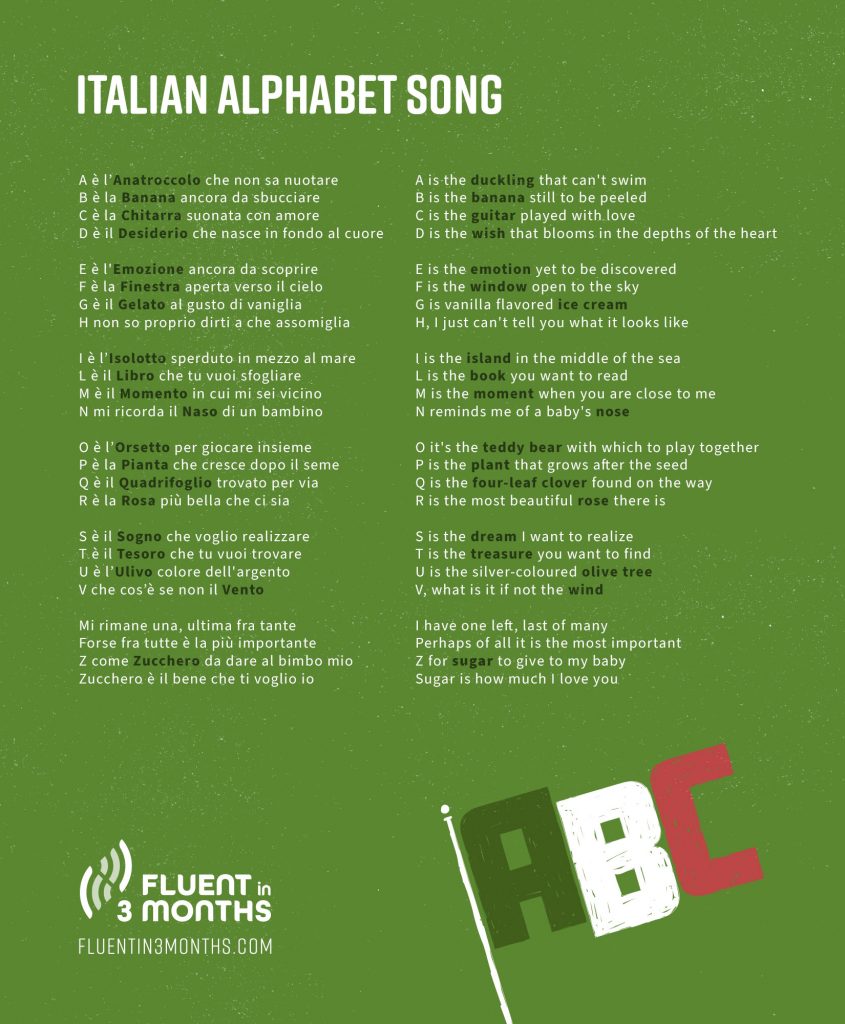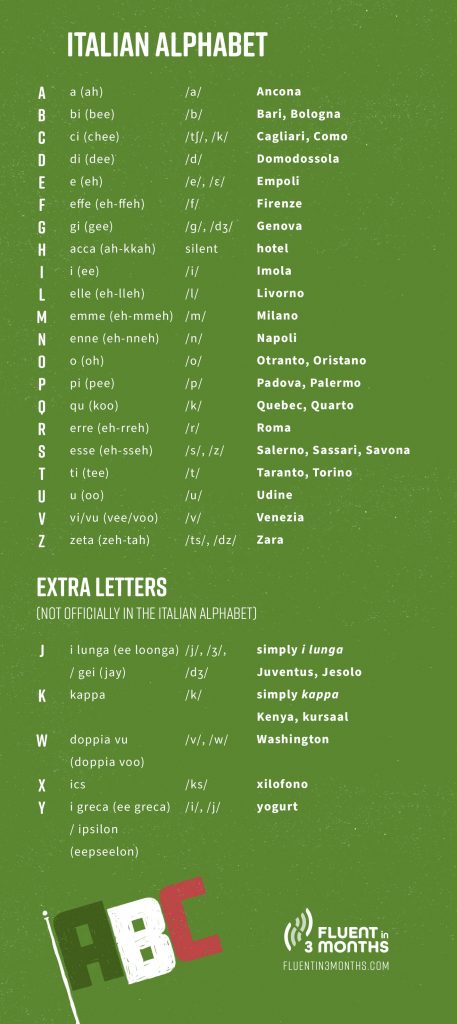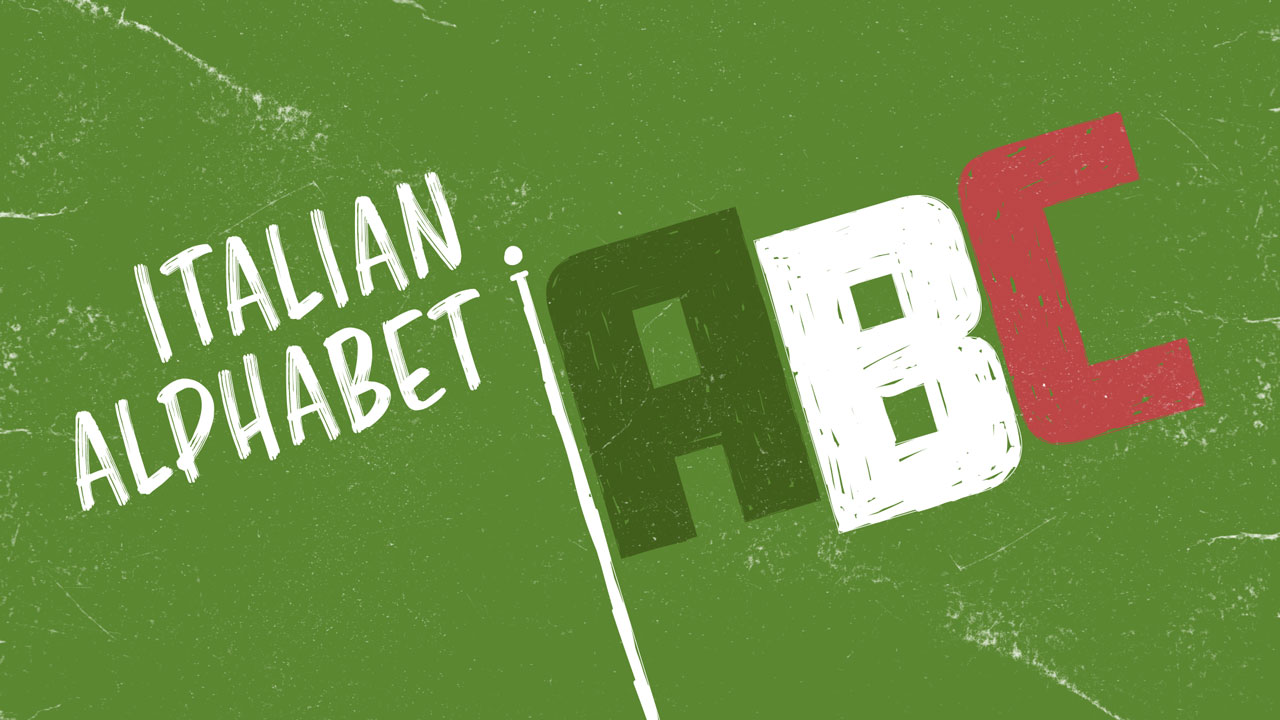A Guide to the Italian Alphabet and Italian Pronunciation (With Audio!)
The Italian alphabet makes Italian easy to learn. And I’m not just saying that because I’m Italian myself!
Italian is a phonetic language. This means that you pronounce words as you read them and write words as you hear them.
This makes Italian easier to learn than languages like French, in which patient is pronounced “passien” and est is pronounced “eh”. Or even English, where sounds like “-ou” aren’t the same in “though”, “thought”, and “sound”.
If you learn the Italian alphabet and a few rules that come with its letters, you will be able to improve your Italian very quickly in very little time.
The article below goes in-depth on the topic. If you want a quick overview (with pronunication) here's a video I made:
Table of contents
- Italian Alphabet 101: A Pronunciation Guide
- Italian ABC: The Italian Alphabet Song
- Italian Alphabet Pronunciation: Let’s Make Sense of the Italian Alphabet Sounds
- A to Z in Italian: How Italians Spell Out Words with a Phone Alphabet
- I’ve Learnt The Italian Alphabet – What’s Next?
To keep things consistent, I’ll use the International Phonetic Alphabet (IPA) to help you make sense of the sounds. And if you’re not familiar with it, don’t worry! I’ve included a lot of audio to make sure you can get the pronunciation right.
Andiamo! (“Let’s go!”)
Italian Alphabet 101: A Pronunciation Guide
How many letters are there in the Italian alphabet?
Officially, the Italian alphabet is made up of 21 letters. That’s five less than English, whose alphabet contains 26 letters.
Wait, what?
Before we dive into a search for the missing letters, let me introduce you to the ones that turned up to create the Italian alphabet.
These are the 21 letters of the Italian alphabet:
Now that you’ve taken a good look at them, you might be wondering: what happened to J, K, W, X, and Y? Long story short: they’re not official letters of the Italian alphabet.
What Letters Are Not in the Italian Alphabet?
The official Italian alphabet does not contain a , , , , or . While this might seem strange, it has a very simple explanation: these letters were, until recently, not needed in the Italian language.
Need an example to wrap your head around this?
If you’re interested in etymology (the study of word origins), you might know that some of the words we use in everyday English come from Ancient Greek. One of them is the prefix “kilo-”, that we find in words like “kilogram” and “kilometer”.
In Italian, the “k” in “kilo” was replaced with the two-letter combination ch because when ch is followed by e or i, it makes a /k/ sound: .
However, like any other ‘modern’ language, Italian has evolved and continues to do so. It gets influenced by other languages, takes loan words, and adapts its vocabulary.
That’s why nowadays, Italian uses words borrowed from other languages, such as “yacht” and “karate”, which haven’t changed to adapt to the Italian spelling. For this reason, the ‘extra’ five letters are sometimes included in the Italian alphabet.
Italian ABC: The Italian Alphabet Song
What’s the Italian alphabet song? I had to think hard about this one because I couldn’t remember an easy Italian alphabet song.
When I asked my Nonna (“grandmother”) for one, she sent me a filastrocca (“nursery rhyme”):

It’s quite long, and probably overwhelming for you if you’re a beginner Italian learner. In fact, I can almost hear you asking: “Doesn’t Italian have an easy ABC song?”
Well… Originally, no, we don’t have a simple alphabet song. However, there is a way to fit the Italian alphabet in the melody of the English ABC song.
Like I mentioned earlier, this version includes the five ‘extra’ letters that don’t officially belong to the Italian alphabet. But it’s a great way to learn how to pronounce all of the letters, and no one will hold it against you.
Italian Alphabet Pronunciation: Let’s Make Sense of the Italian Alphabet Sounds
Now that you’ve learnt the name of the letters, let’s go over the sounds they make.
As I’ve already told you in the introduction, Italian is a phonetic language. This means that, if you know what Italian letters and letter-combinations sound like, you’ll be able to pronounce any new words you see while reading in Italian.
See what I meant when I said learning the alphabet would speed up your progress?
Let’s start by looking at the vowels.
Vowel Sounds in Italian
The sounds of the Italian vocali (“vowels”) are pretty straightforward: they’re mostly identical to the vowels’ names.
- → /a/
- and → /ɛ/ and /e/
- → /i/
- and → /ɔ/ and /o/
- → /u/
As you can see, the letter e and the letter o have two pronunciations: one more open and the other more closed.
Here’s a couple of examples to emphasize the difference:
- (“I can”) → /ˈpɔsso/
- (“good”) → /ˈbɛne/
Note: In Italian dictionaries, the different sounds are indicated like this:
- /è/ for the open
- /é/ for the closed
- /ò/ for the open
- /ó/ for the closed
But it is not necessary to stress out over the difference just yet. It can become more marked depending on the Italian region, and as a Northern Italian myself, I don’t always strongly mark it.
Instead, let’s focus on how Italian vowels make your life easier by staying true to their sound(s).
In English, “o” and “u” become a single phonetic sound in “thought”, but this doesn’t happen in Italian. Even when you combine several of them, you pronounce each vowel as you know it: they don’t blend into a new sound!
Examples:
Consonant Sounds in Italian
Many of the Italian consonants make the same sound they do in English. I will bold them in the list:
- B – (“white”)
- C
- D – (“dice”)
- F – (“flower”)
- G
- H
- L – (“light”)
- M – (“hand”)
- N – (“nine”)
- P – (“door”)
- Q
- R
- S – (“sun”) and (“house”)
- T – (“a lot”)
- V – (“voice)
- Z
This leaves us with C, G, H, Q, R, and Z, which sound different in Italian.
The Consonants that Sound Different in Italian and English: C, G, H, Q, R, and Z
The Consonant C
In Italian, the letter C on its own can make two sounds: a hard /k/ or a soft /tʃ/. This depends on the letter that follows.
When C comes before:
- A, O, or U, it is pronounced /k/:
To make the C sound like a /k/ before E or I, just add an H after it:
Before we move on to the next letter, let’s talk about one last sound that C can make in Italian.
We saw that when C comes before another consonant, it makes the sound /k/. But when C follows the letter S, it can make two sounds: /k/ or /ʃ/.
When SC comes before:
- A, O, U, H, or another consonant, it’s pronounced /sk/:
The Consonant G
G works in a similar way to C in Italian.
When G comes before:
- A, O, or U, it’s pronounced /ɡ/:
G is paired with H to form the sound /g/ in front of E and I:
Just as S and C can form a new sound together, G can create a new sound when paired with other consonants:
- G followed by L and I makes the sound /ʎ/:
The Consonant H
In Italian, the letter H doesn’t really have a sound.
It can either be:
- silent at the beginning of a word: (“you have”) and
- or used to modify the pronunciation of C and G, like we just saw.
The Consonant Q
In Italian, the letter Q makes a /k/ sound. As a general rule, unless the word is borrowed from another language, Q is followed by U.
Examples:
The Consonant R
It was quite easy to explain the Italian sounds so far because they’re similar to English sounds, or easy enough to reproduce by English speakers. But the R is different.
If you can’t pronounce the R in (“rare”) or (“to laugh”), I’ve got the perfect guide for you.
Benny Lewis, founder of Fluent in 3 Months, put together a list of six techniques to help you roll your R.
This is also the perfect post if you’re learning Spanish, Hungarian, or any other language with a rolled R.
The Consonant Z
You can pronounce the Italian Z in two ways:
- a hard /dz/: (“backpack”) and
- a soft /ts/: (“song”) and (“March”)
The soft /ts/ sound resembles the sound of the double consonant ZZ.
Speaking of double consonants…
Italian’s Crazy Love for Double Consonants
Italian consonants sound different when duplicated. Some people say they sound longer, some say they sound more harsh. I’ve always paid more attention to the short pause I make that marks the beginning of the double consonant.
I’ll let you decide what they sound like to you:
- BB: (“we have”),
- CC: , (“hunt”)
- DD: (“goodbye”)
- FF: (“coffee”)
- GG: (“trip”)
- LL: (“rooster”)
- MM: (“mom”)
- NN: (“grandma”)
- PP: (“double”)
- RR: (“tower”)
- SS: (“red”)
- TT: (“cat”)
- VV: (“obvious”)
- ZZ:
There are double consonant sounds in English, too. They’re not usually within a single word, but you can hear it clearly when one word ends with the same letter that the next word begins with.
For example, the S sound in “I miss Sally” is a lot longer than it is in “I miss Ali”. So is the N sound in the phrase “one note” compared with “one oat”.
Fun fact: In the South of Italy, people tend to double the consonant at the beginning of a word when they talk, like this:
- (“people”) becomes
- (“maybe”) becomes
It’s only an oral habit, it doesn’t apply to writing.
Pronunciation of the ‘Extra Five’ Letters in Italian
Here we are again with the five extra letters: J, K, W, X, and Y. But with good news!
Since they only appear in borrowed words, pronounce them as they are pronounced in those words!
A to Z in Italian: How Italians Spell Out Words with a Phone Alphabet
If you’re going to travel to Italy, there’s something you need to know about how Italians spell out words. We’re going to talk about l’alfabeto telefonico (“the phone alphabet”).
Phone alphabets are not uncommon in other languages and countries. In fact, you might be familiar with military-style phone alphabets. In the NATO one, Alpha stands for A, Bravo for B, Charlie for C, etc.
The Italian phone alphabet is still frequently used in Italy to avoid confusing letters like and or and over the phone.
If you’re going to spell out your name to make restaurant reservations or you’re giving someone the name of the street where you’re staying, you might want to learn which words Italians associate to each letter of the alphabet.
Here’s a table to help you with that:
| Letter | Phone alphabet |
|---|---|
| A | Ancona |
| B | Bari |
| Bologna | |
| C | Cagliari |
| Como | |
| D | Domodossola |
| E | Empoli |
| F | Firenze |
| G | Genova |
| H | hotel |
| I | Imola |
| L | Livorno |
| M | Milano |
| N | Napoli |
| O | Otranto |
| Oristano | |
| P | Padova |
| Palermo | |
| Q | Quebec |
| Quarto | |
| R | Roma |
| S | Salerno |
| Sassari | |
| Savona | |
| T | Taranto |
| Torino | |
| U | Udine |
| V | Venezia |
| Z | Zara |
The phone alphabet has also extended to include the five ‘unofficial’ letters of the Italian alphabet. You’ll notice that, unlike almost all the letters from the official alphabet, not all of the 5 extras go with a city:
| Letter | Phone alphabet |
|---|---|
| J | simply i lunga |
| Juventus | |
| Jesolo | |
| K | simply kappa |
| Kenya | |
| kursaal | |
| W | Washington |
| X | xilofono |
| Y | yogurt |
Wow, this all looks like a lot. Don’t worry, you don’t have to learn all of them now!
Here’s an infographic that you can print out and keep with you when you travel:

I’ve Learnt The Italian Alphabet – What’s Next?
Now that you’ve learnt all about the Italian alphabet, you’ll be much more confident in your Italian reading, writing, and speaking.
Just think about it! Pronouncing the 500 core Italian words? Easy peasy. And because you’ll find it easier to pronounce them, you’ll remember them better.
And if you’re working with a language tutor, you’ll be able to understand what they say quicker because you’ll recognise the sounds they use to form words.
So, well done for deciding to learn the Italian alphabet!
If you want more amazing Italian content, the Fi3M blog is your gold mine. Head over here for more grammar, vocabulary, and culture.
To complement your learning, you could use one of Benny Lewis’s favourite resources to learn Italian. As the founder of Fluent in 3 Months, he’ll only give you il meglio del meglio (“the best of the best”).
Alright, I’ll leave you to it.
Ciao!



Social